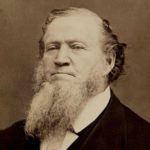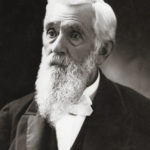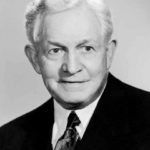 Those who wear beards must be rebelling against something, because a clean cut look represents conservative and productive lives. They are not following the LDS leadership’s example. About 15 years ago that would have been the argument, and not without some truth from the past. Like all fads of fashion the times have changed. Beards are no longer grown to make a clear statement. For most of those who grow one today it is about physical comfort and convenience, if not the look. Beards may not be widespread, but a lot of faithful Mormons are growing them when they wouldn’t have not too long ago. And that is just fine.
Those who wear beards must be rebelling against something, because a clean cut look represents conservative and productive lives. They are not following the LDS leadership’s example. About 15 years ago that would have been the argument, and not without some truth from the past. Like all fads of fashion the times have changed. Beards are no longer grown to make a clear statement. For most of those who grow one today it is about physical comfort and convenience, if not the look. Beards may not be widespread, but a lot of faithful Mormons are growing them when they wouldn’t have not too long ago. And that is just fine.
 Despite Joseph Smith as the founding prophet never having a beard, prophets for generations who followed him had one. In fact, there are prophets that could be recognized by their beards alone. Brigham Young, John Taylor, and Wilford Woodruff had chin beards without mustaches. Lorenzo Snow and Joseph F. Smith had long flowing beards. Heber J. Grant and George Albert Smith had relatively short facial hair. There were even times and places where having a beard was required by missionaries because it represented maturity.
Despite Joseph Smith as the founding prophet never having a beard, prophets for generations who followed him had one. In fact, there are prophets that could be recognized by their beards alone. Brigham Young, John Taylor, and Wilford Woodruff had chin beards without mustaches. Lorenzo Snow and Joseph F. Smith had long flowing beards. Heber J. Grant and George Albert Smith had relatively short facial hair. There were even times and places where having a beard was required by missionaries because it represented maturity.
 It wasn’t until the clean shaven President David O. Mckay that beards started going out of fashion for LDS leaders. His lack of a beard was a conscious choice. He wanted to make a statement about leaving the pioneer past and go forward into the future. That future in the 1950s was the neat, professional, and respectable businessman look. The “unkempt” look of a hairy face was out, even if only one generation ago they were signs of maturity. For the post-WWII years a suit and a tie with a shaved face meant achieving the American dream. After more than 100 years of persecution and living in the wilderness, the LDS Church had come out to join respectable society.
It wasn’t until the clean shaven President David O. Mckay that beards started going out of fashion for LDS leaders. His lack of a beard was a conscious choice. He wanted to make a statement about leaving the pioneer past and go forward into the future. That future in the 1950s was the neat, professional, and respectable businessman look. The “unkempt” look of a hairy face was out, even if only one generation ago they were signs of maturity. For the post-WWII years a suit and a tie with a shaved face meant achieving the American dream. After more than 100 years of persecution and living in the wilderness, the LDS Church had come out to join respectable society.
At the historical moment when Mormonism and Americanism started to get along, social norms were challenged and changed. Suddenly long hair and long beards were “in” among a large number of the young. The very ideals of American society that stood the test of time were thrust into turmoil. For all the work and patience to “fit in,” Mormons once again found themselves outside the mainstream. It is true Mormons were not the only ones who became concerned with the direction of the nation. What made it troublesome to Mormons more than many others was an uncertainty where the Church belonged in this new society. Beards were a physical representation of this existential confusion.
The counterculture movement took up long hair and heavy beards as part of their protesting. The new respectable clean shaven look was challenged by the once mature representing facial hair. It became associated with youth rebellion, drugs, promiscuity, and social deconstruction. All of these hit the hardest on college campuses because of the relative ages of the counterculture followers. Brigham Young University leadership saw what was happening around them and took precautions. Long hair and beards, that LDS Church authorities had already stopped wearing, became forbidden as part of other style related codes. The war on beards started and remains in place to this day.
Attitudes about beards have changed over the years both in society and Mormonism. Having or not having one is not seen as any particular statement. Long beards, short beards, and no beards can be found in all levels of American society with no class distinctions. Even in the LDS Church members grow beards, shave, and grow them again without anyone complaining. It isn’t about an increase in liberal leaning Mormons going against the grain. Very faithful and conservative Mormons, particularly in rural areas, have gone through this cycle without blinking. The days of beard shaming among Mormons is close to over.
That doesn’t mean non-beard requirements in the LDS Church have or will go away. Missionaries, leaders, BYU Students, and Temple workers are not allowed to grow them. The question is if this should change or be relaxed? Considering that beards still hold some residual symbolism of rebellion and more often laziness, leaving them off in certain circumstances should stay. Must they stay? no, that isn’t a particularly compelling position to hold. However, at the moment a shaved face still represents a professional look.
Rarely is there seen on television, in the office, or among politicians any facial hair along with a suit and tie. Missionaries, leaders, Temple workers, and even BYU students (whether they like it or not) act as representatives of the LDS Church in more or less an official capacity. If the LDS Church was to change to allow beards in those circumstances, they would be going against current societal norms. There is no compelling reason for such a difference. Social norms about beards would have to drastically change (such as between the pioneer and modern era) before restrictions can be dropped. Casual wearing of beards is fine. Wearing them while in an official position is not; at least not yet.


My brother was a temple worker when our temple would stay open 24 hours a day through the weekends. At the time he wore the same hairstyle he sports now, which features long hair on one side and all the beard that nature allows him to grow.
We now know he is autistic, though I don’t believe that was known in the 1990s. He once explained that when he was clean shaven and normally coiffed, people would presume he was normal and then be disappointed when he wasn’t. Since my brother started growing his hair and beard in a long and atypical style, he doesn’t get anyone who is disappointed. Instead, the portion of the community willing to interact with an unusual person is free to interact with him and others stay away.
There was a time when my husband’s relatives came to our town. It was the first time the wife had been to the temple in years (since encountering someone who had victimized her in that hallowed context) and the husband came seeking guidance about whether to leave a job or adhere to the strenuous grooming requirements. My brother officiated at the session they attended. My brother’s lack of “standard” grooming was the answer to the husband’s question. Because if my brother, with his long hair, could be a temple worker, then the husband felt that he didn’t need to conform to the strenuous grooming standard for a job he was conflicted about in the first place. As to the wife, I think she enjoyed returning to the temple in a setting where a known family member was officiating.
The temple worker restriction is relatively recent. My understanding was that it was up to the temple president for each temple until about ten years or so ago. I’ve certainly known several temple workers with beards in the past.
Clean shaven faces are now mandatory in the temple, but the BYU vending machines sell caffeinated soft drinks. And cars drive themselves (or at least park themselves). The world is a new and different place.
In the early 2000’s I was a temple worker and had a goatee. I stopped being a temple worker when they made up the rule that temple workers not having beards.
I work at a relatively conservative financial services company in the Fortune 30. As I told my grandfather, who gave me a hard time about my facial hair when I saw him, it was ok for me to wear a neatly trimmed beard at work because my boss had a beard and his boss had a beard. My boss’s boss’s boss didn’t have a beard because she was a woman.
OP’s like this try and pretend that societal norms are stuck in the 1980’s. It may be true that Utah norms require officials to be clean shaven, but I think that has more to do with Utah than with US society. (Wouldn’t it be great if Utah caught up with society on not just facial hair, but on the ratio of male to female leadership too? Wouldn’t it be great if in UT, your boss’s boss’s boss, a very senior executive, was clean shaven not because he was bowing to outdated societal norms, but because your boss’s boss’s boss was a SHE?)
I have a neatly trimmed beard. But the only thing I am rebelling against is ingrown hairs and the fact that I look better with facial hair.
The only thing that will end this silly cultural battle from the 1960’s is the realization that beards are no longer a cultural statement, they are simply an acceptable grooming option. Beards shouldn’t even be mentioned in any church policy.
I think sporting a beard is equivalent to violating the Law of Chastity and it should be punished accordingly.
Aaron B
Aaron B, welcome back. Give my regards to Prudence McP.
Thanks for the interesting article jettboy. I find the resurgence of beards to be kind of interesting and often enjoy teasing my wife about growing a beard (she is firmly against it). However, I think that attributing the end of LDS beards to David O. McKay and the 1950s is pretty far off the mark.
Judging from the pictures of my ancestors the “end of beards” started long before then. More like around the turn of the 20th century. My 2nd-great grandpas (born ~1850) all (or nearly all) had beards. Nearly all of their sons were clean shaven. This is very evident from family photos taken around the turn of the century.
David O. McKay just happened to be a member of a generation that was by and large clean shaven. He wasn’t the cause of it.
There is absolutely no broad requirement that church leaders not have beards. I just finished a 5-year stint as bishop with a goatee in place the entire time. Beards are still uncommon, but we have several high councilmen with beards to one degree of fullness or another. And several with mustaches. We can represent the church just find with beards
My husband started wearing a beard. He recently got a new job with a national company, and we found out that 6 months ago, they didn’t allow beards.
I’ve become much more beard-aware, and often look around and count the beards. It isn’t uncommon to find up to half of the men in the room to be wearing a beard of some kind. And I live in Utah County.
Tom D is right. When David O McKay was a junior apostle, he was clean-shaven when the older apostles had beards; the rebel.
Just for fun:
https://www.spreadshirt.com/trust+me+i+have+a+beard+t-shirts-A101963163
Maybe David O McKay didn’t have the reasons that I stated, but it was something I remember reading somewhere. That doesn’t mean he didn’t represent the change of the new generation:
“By 1951 church President David O. McKay directed efforts to transform the look of Latter-day Saint men. One hypothesis is that President McKay wanted to modify the image of the church to escape the depiction and correlation between Mormon men and polygamy. Mormon polygamist leaders were known for having beards.
With the loss of polygamous activity with George Albert Smith, (David O. McKay’s predecessor) we can see a drastic transition from bearded polygamists to clean shaven monogamists. Although there is no written statement, the hypothesis makes sense logically. Nevertheless, is there any statement made during this time that can aid us in understanding why beards were no longer a part of Mormon culture? ”
http://michaelahickman.blogspot.com/2013/03/iron-beards-and-leave-me-alona-beards.html
He notes there wasn’t any solid quotes until the late 1970s, but it is still a hypothesis that seems to hold weight.
Jett boy,
A hypothesis with no supporting evidence holds weight?
Sorry, the only evidence we have is that members followed the post-WWII popular trend and abandoned facial hair. The counterculture iced the cake. One day men will come to terms with their manliness and stop scraping their faces in the name of political correctness.
How about….”if God didn’t want men to have beards, He wouldn’t have…(bla bla bla bla……) (fill in the blas)
Here’s a pic of the Q12 including George Albert Smith, David O McKay, and John Widtsoe.
https://www.lds.org/bc/content/shared/content/images/gospel-library/manual/32496/32496_all_005_01-Twelve.jpg
ELders Smith and Widtsoe have facial hair, and maybe one other; can’t tell due to graininess.
Widtsoe was ordained apostle in 1921, so that’s the earliest the pic could be.
Smith was ordained president in 1945, so that’s the year range.
And at least nine are clean-shaven.
I found one pic of Pres McKay as a missionary with a mustache, and another of him as a young man, looks pre-mission, clean shaven.
McKay was ordained an apostle in 1906.
“One day men will come to terms with their manliness and stop scraping their faces in the name of political correctness.”
Yeah, no thanks. I HATE wearing a beard and am grateful for the availability of great equipment to cut them down to the very root.
Interesting point in OP “Rarely is there seen on television, in the office, or among politicians any facial hair along with a suit and tie.”.
This seems true. I’d be curious to see some hard numbers, e.g. a count of US senators and congressmen who have facial hair vs. not vs. not because they are female. It will be interesting to see if that trend changes with time, as my generation (nearing age 40) assumes more and more of such roles. For us, as was noted, facial hair isn’t a strong marker of anything unlike for our parents.
Lucas, I will not think ill of you if you can’t grow a beard. And some women appreciate that prepubescent look.
“Lucas, I will not think ill of you if you can’t grow a beard. And some women appreciate that prepubescent look.”
That’s why I like it! I get to be younger for longer hehehe
I currently serve in a bishopric and would like to have a beard but our stake president has been pretty adamant that those in the bishopric should be clean shaven. Before being called to the bishopric, I served in a EQ presidency where every one of us had a beard. (I live in Utah County.)
It’s one of those silly cultural things like (until recently) the no caffeine at BYU issue. Personally, I don’t have a problem with a bishop, a stake president, or anyone else in a leadership position having one so long as it’s maintained and neat. At the same time, I don’t see this as a battle worth fighting with my stake president or bishop or anyone else. So I’ll remain clean shaven until I’m released. At which point I’ll grow out my beard again.
For bishoprics I think it’s more up to the Stake President to decide the grooming. I know for years our old stake president wanted everyone in the bishopric to shave because that is what the brethren did.